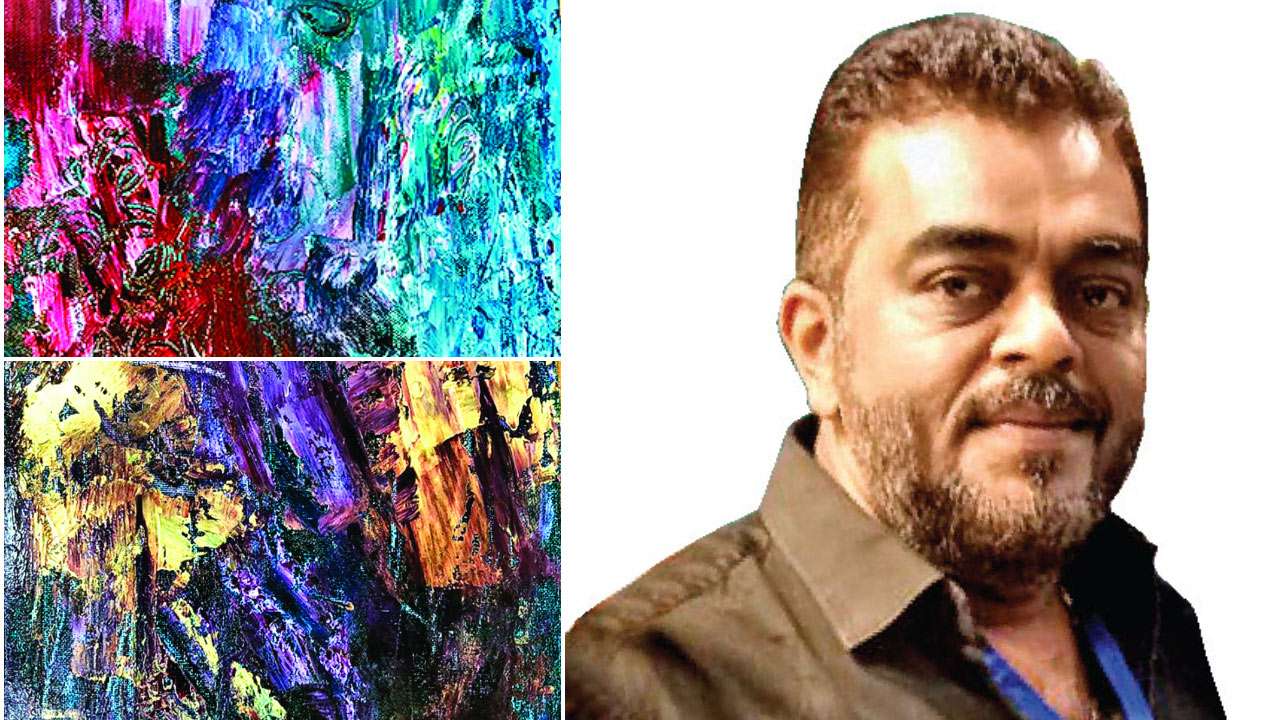Suresh Nair (Left) Abstract artworks painted by visually impaired students under the tutelage of (right) artist Suresh Nair
Some find the smell of freshly painted walls intolerable. Even acrylic and oil paints, and thinning agents like kerosene and turpentine. Others find the mild scent of wax crayons and colour pencils, or the muddy whiff water colours emit, comforting. For artists, entering their studio rife with the smell of paints is akin to a homecoming. Even with eyes shut, the smells, scents, fragrances, of the associative colouring mediums are instantly identifiable.
Exactly what made Suresh Nair, a Maharashtra Housing and Area Development Authority (MHADA) contractor and a self-taught Mumbai-based artist, and his art partner Samina Sachak from Tasmania, to create a solution that allows people with visual impairments use their olfactory senses to paint. His patent brand, Paint Aroma, is a box of 10 acrylic paints, each colour infused with a natural essence that best represents it. So white emits the scent of vanilla, yellow – citrusy lemon, yellow ochre – lemon grass, burnt sienna – cinnamon, crimson – strawberry, Prussian blue – lily. “I purposely didn’t add chocolate essence to the brown as the kids may want to eat it,” chuckles Nair.
 The thought of enabling people with limited or no vision to enter the art world was born at last edition of the India Art Festival at Thyagaraj Stadium, Delhi, that Nair participated in. The visually challenged students who visited his stall became quite excited on moving their hands over the 3D birds and nest he’d created. He felt their deep yearning to comprehend art. After much research and assistance of a paint manufacturer, Nair developed a range of scented paints. As part of R&D, he introduced these paints through a set of six art classes at various schools for blind kids in Delhi and Mumbai. Convincing schools to come on board is tough. “The school’s trustees don’t take art seriously. I end up paying for the canvas, brushes and colours from my own pocket. Many schools for the visually challenged don’t have a proper art curriculum. The children are only trained to make sculptures from clay.”
The thought of enabling people with limited or no vision to enter the art world was born at last edition of the India Art Festival at Thyagaraj Stadium, Delhi, that Nair participated in. The visually challenged students who visited his stall became quite excited on moving their hands over the 3D birds and nest he’d created. He felt their deep yearning to comprehend art. After much research and assistance of a paint manufacturer, Nair developed a range of scented paints. As part of R&D, he introduced these paints through a set of six art classes at various schools for blind kids in Delhi and Mumbai. Convincing schools to come on board is tough. “The school’s trustees don’t take art seriously. I end up paying for the canvas, brushes and colours from my own pocket. Many schools for the visually challenged don’t have a proper art curriculum. The children are only trained to make sculptures from clay.”
But the students, he says, are fast learners. Within the first three classes, they perfect different brush strokes, identify colours by scent, and gauge the size of the canvas to paint on. “I take their hand and move it in the way a brush stroke needs to be made. But I never touch up the paintings. I don’t need to as they turn out just fine.” The paintings are all formless, abstract works, in a myriad of hues including gold, all blending on canvas after being chosen purely on the basis of scent.
“The paints are non-drip, so it’s not a hassle if the container accidentally falls or turns over. The thick pigment has no water for a no-spill outcome,” says Nair. To paint with these hues, add a dollop of paint to the palette, dip the brush in a bowl of water and then dab it in the colour. “This part is a minor hurdle for the blind people as they have to estimate how much is too much water. Otherwise the end result will appear too diluted.” The scent evaporates in 12 days and Nair feels this is fine as not everyone will appreciate the stagnant fragrance in and around the space where such paintings would hang. “I ensure that every colour is kept at a distance from the other and that all 10 are not used at one time because the scents will confuse the students. I also have a rule that every bottle must be shut immediately after use.”
Few other art initiatives have also tried such experiments with sight and paint. Topsail Island Visions, a North Carolina company, provides kits with textured canvases and scented paints that visually impaired artists can touch and paint using their fingers. Closer home, Siddhant Shah adds scents to his 3D tactile replicas of artworks at ongoing exhibitions, meant for partially/completely blind patrons to touch and discern the artists’ body of works. Mumbai has a College of Fragrance for the Visually Impaired, which trains blind students to harness their olfactory senses and work in the perfume industry. Nair too, wants to promote the works of his talented students. “I’m working out a deal with schools where I can collect the best paintings and auction it on behalf of the student, for their welfare.”
Source: Scented Sight: A special set of paints for visually impaired artists













